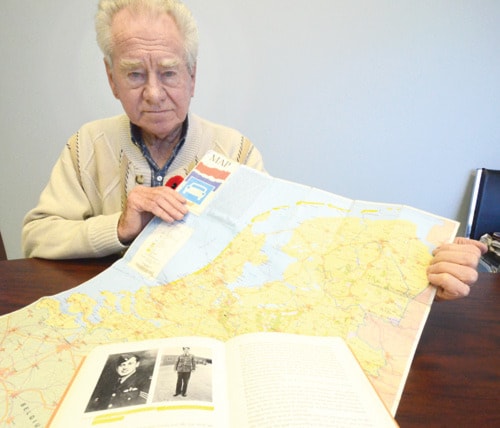Nearly six decades after the end of the Second World War, Joe Van Dyke still has clear memories of the war, and of the courage of a young Penticton man who gave his life in an air raid.
Van Dyke was just a teenager when the German army occupied his hometown of Stadskanaal, Holland. He remembers the lineups to get food and fuel for the stoves and he remembers the restrictions placed on daily life by the occupying forces.
But his most vivid memories are of the great bombing raids, attacking the German port and manufacturing centres of Bremen and Hamburg. And one in particular, where a returning bomber crashed a block away from him, killing two of the crew members, including Pentictonite George Coldron.
That was Sept. 14, 1942. Engines shot out by a German fighter plane, the Hampden bomber Coldron was in limped back over the Dutch border. The plane had a four-man crew. Two survived, but Flight Sergeant Roman Grabek and the young observer perished. Sergeant George Edward Cragg Coldron, the son of Percy and Grace Coldron of Penticton, was just 20 years old, and in the final stages of his training.
Van Dyke was 14 years old at the time, but decades later, when he moved to Penticton, he had hopes of making contact with Coldron’s family.
“I tried to find his family, but they were gone, I couldn’t get a hold of them,” he said. “They were young kids, just a few years older than I was. There were four people in the same plane. The other two were able to jump but were caught by the Germans.”
The plane went down about half a block away from Van Dyke’s home, crashing between two houses. But it wasn’t until the next morning that Van Dyke got a good look at the scene. There wasn’t much damage to either of the two houses, he recalls, but the wreckage was extensive.
“It was a mess, an awful stink. You could smell the burning gasoline and the plane was smashed, little bits all over the place,” said Van Dyke.
The townsfolk buried Coldron in the Stadskanaal cemetery, where he remains, his grave marked with a headstone bearing the RCAF insignia.
Remembrance Day ceremonies honouring all Canada’s veterans begin just after 10 a.m. today as the parade gathers at the Penticton Curling Rink parking lot before marching to the Trade and Convention Centre, where the official ceremonies begin at 10:30 a.m. Two minutes of silence will be observed at 11 a.m. followed by the laying of the wreaths.
“The planes came right over our town. They were large missions with hundreds of planes,” said Van Dyke, remembering the droning of the British bombing missions approaching at night on their way to targets in Germany. “As soon as they were past us, my brothers and I used to climb on top of the roof. We would hear the bombs drop and you would see the sky light up.”
Van Dyke said he and his brothers were frightened, but they also needed to see what was going on.
“You are still scared, but you wanted to know,” he said. The target cities were about 50 km away, but the boys on the roof could still see and hear the bombs dropping, the sky lighting up from the explosions. “It’s a long way, but if they drop 1,000 bombs, it makes a noise.”
As much as he remembers the sounds of the bombs, Van Dyke also has clear memories of the sounds of the Canadian Forces coming to liberate their town. First, there was the sound of the fighter planes and the shells fired over the town to weaken the German forces. But then there was the sound of a town down the road celebrating their own liberation.
“I can still hear that. They were just hooping and hollering all night,” said Van Dyke. “Their town was liberated the day before us. And you could hear those people celebrating all night and we had to wait for another day. Then the next morning they came through and we were liberated.”
